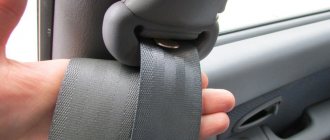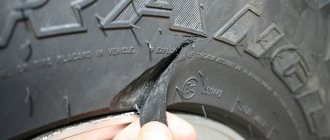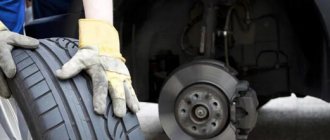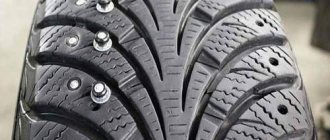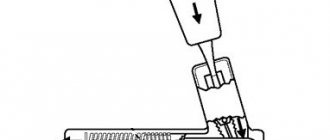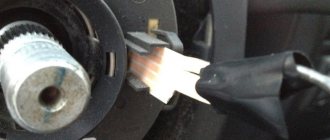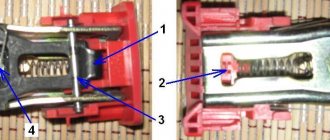The chemical composition of modern road rubber is very complex. In addition to traditional components such as rubber, oils and carbon black, there are many chemical impurities that affect the performance of wheels and their wear resistance. Thanks to additives, rubber gains wonderful properties, but begins to adversely affect the environment. Carbon black and other chemical elements in tires, when heated, release volatile substances that create a characteristic unpleasant odor. These fumes contain carcinogens that pose a real threat to human health.
Article on the topic Taking off your shoes at the wrong time. Why can't you ride with a hernia on a wheel? In 2003, IARC (International Agency for Research on Cancer) published the data of its scientists. The research was carried out over 35 years in the USA at tire factories. It turned out that workers in these industries are susceptible to cancer of the respiratory tract and circulatory system 10 times more often than the US average. In addition, with frequent contact with the rubber compound, the risk of allergic diseases is high. It is not surprising that, in accordance with Russian legislation, tires are classified as substances of hazard class 4.
WHO does not recommend collecting herbs, berries and mushrooms along highways, because rubber wear products turn into dust and settle as a harmful coating on the side of the road near the asphalt surface. For the same reason, old tires should not be left in publicly accessible places and should not be buried on the lawns in front of the house to avoid contact with melt water and harmful substances entering the soil. Tires must not be disposed of with household waste due to the risk of soil and wastewater contamination. They must be handed over to special detention centers.
Tires are prohibited from being stored in residential premises; they cannot be stacked in the hallway or on mezzanines under the ceiling. It is forbidden to leave it under the bed in the bedroom. This is dangerous to your health.
Basic nuances of storage by type of tires
Tube and tubeless tires
- In this case, the tube should be stored inside the tire in a slightly inflated state. This is done so that folds, bedsores and cracks do not form on the product, and the camera itself lasts longer. The tire should be on edge and regularly rotated 90 degrees at least once a month. This is necessary so that the cord does not deform.
- The storage requirements for tubeless tires are the same as for tube tires.
Difference in conditions for the safety of summer and winter tires
The differences in how these tires are stored are small, but they still exist. So:
- Before storing winter tires, they must be thoroughly washed to remove reagents and other chemicals used to treat roads. It is enough to wash away dust and dirt from summer wheels.
- Summer tires can be stored outside (under a canopy) in winter, but not for long, about a month, and with some reservations (see below).
- If the car is not used in winter and is parked on the street with summer tires installed, you need to jack up the car using a sawhorse (boards or wooden beams), thus unloading the tires. In this case, it is better to lower the tire pressure, the minimum allowable is 0.6–0.8 atmospheres. At the beginning of its service life, the car is first lowered, and then the wheels themselves are inflated to the required parameters.
Tire storage according to GOST
Let's turn to the state document regulating the standards for packaging, transportation and storage of tires. It is called GOSTR 54266 - 2010. Basic recommendations for storing rubber specified in the document:
- In the storage room, the air temperature can range from -30 to +35 degrees. Moreover, if the rubber was stored in the cold, it must be kept in a warm room before installing it on the car.
- Do not leave tires closer than 1 m from sources of artificial heat.
- Tires should only be laid on a flat surface. This could be a floor, a rack or a pallet.
- If the width of the tire profile does not exceed 20 cm, place them horizontally on top of each other, not exceeding a height of 2 meters.
- Store larger tires with a profile width of 21 cm or more vertically.
- Change the position of the rubber every 3 months.
- If the tires are tubeless, position them so that their surface does not deform.
- If tires have already been used, thoroughly clean the surface before storing.
- Tires are allowed to be stored outside, but only for no more than a month. At the same time, they must be isolated from external influences, for example, folded under a canopy or covered with an awning.
By following the prescribed storage standards, you will ensure your wheels last a long time.
Where to store car shoes
With and without disks on the apartment balcony
Tires and rims should be stored in a stack, as shown in the picture below. They need to be covered with an opaque and moisture-resistant material, for example, oilcloth or tarpaulin.
It is important to understand that an unglazed cold balcony is the same as a street, and you should not store rubber on it.
Tires on rims should be stored horizontally, stacked
Wheels without rims should be stored vertically. You can put them in boxes, make special cabinets, or simply lean them against the wall. Like tires and rims, they need to be wrapped in some kind of opaque and moisture-resistant material. Don't forget to turn the tires 90 degrees every month.
Tires without rims should be stored “on edge”
How to properly place it in the garage
Just like on a balcony, tires on rims can be stored in a stack. There is another way: screw special hooks into the roof or wall and hang the wheels. This type of storage can be seen in the picture below.
Tires on rims can also be stored suspended using hooks and straps
Is it possible to leave tires outdoors in the cold?
You can store tires outside for no more than one month, but not a single manufacturer will recommend this storage method for the following reasons:
- Sudden temperature changes. In summer and spring, the difference in temperature at night and during the day can be tens of degrees. This mode can lead to cracks in the tires.
- Dust and dirt. Because of them, tires can lose their presentation, crack and lose their properties.
- Road chemicals. They may well get on the tires, even if they are located away from the road. They can cause tires to crack.
Features of tire transportation
Poor quality road surfaces lead to rapid wear of tires on wheels. Given the large number of cars, the demand for tires is always stable. The main share of wheel transportation is for spare parts for passenger cars. Tires for bicycles are in second place, and tires for trucks are in third place. Russia not only imports products, but also exports products from local factories.
Sea container transportation of goods is the optimal way to transport goods from geographically remote countries. Delivery by ship provides advantages in the form of low transportation tariffs and a large volume of cargo. Using a container when transporting wheels not only protects the goods from external influences, but also prevents them from being overpacked during the process of changing vehicles. The number of tires loaded into it depends on the product parameters: diameter, width and profile height. Goods can be transported on pallets, but due to the specific shape, there is a lot of free volume left. A more common option is to lay the tires in a herringbone pattern, placing them at an angle of 30° to each other. The laying is dense, empty spaces are filled with separate tires.
The products are not packaged before transportation, but if necessary, tires are wrapped in special paper or polyethylene. This option is specified in the contract. Typically, tires for trucks and cars are delivered in standardized universal containers. But there are large tires for special equipment that are larger than the height of a standard container. Such cargo is transported in Open Top sea containers. In its design, the roof is replaced by an awning.
On board the ship, containers arrive at one of the Russian ports. They are placed in a container terminal for temporary storage and transshipment. Cargo transportation in Russia from the port to the destination is carried out by road. Cargo is transshipped onto a trailer or semi-trailer of a container ship. The transport is designed for transporting sea containers along highways. The platform can accommodate two 20-foot or one 40-foot containers. Road transport is the final stage of the multimodal scheme. In the case of delivery of goods in a groupage shipment, tires are transported in a truck to the customers' addresses.
Rules for the transportation of tires and tires
- Tires can be transported by any type of transport. It is advisable to place them in a vertical position.
- When loading products weighing more than 30 kg, electric forklifts and other mechanisms are used.
- When transporting tires with tubes, the inside is treated with talcum powder or a special lubricant. Air is pumped into the chambers.
- Tires must be protected from high temperatures and avoid contact with mineral oils, solvents, acids, alkalis, and protruding parts of structures.
- When transporting separately, the chambers are rolled up and the valve is tucked inside.
Customs clearance when transporting tires
The set of accompanying documents for the transportation of tires includes an invoice, a bill of lading, a declaration of conformity, a packing list, and a certificate of origin. Transportation of tires from well-known brands requires permission from the copyright holder. The product is included in the list of intellectual property items. To import and sell tires on the territory of the Customs Union, it is necessary to confirm its compliance with current GOSTs. After an expert assessment, the importer transporting tires for trucks, passenger vehicles, buses, and motorcycles is issued a certificate of compliance with the technical regulations TR CU 018/2011. New and retreaded tires undergo the procedure. The safety and lives of people depend on their quality. The certificate is valid from 1 to 5 years.
During customs clearance, HS code and duty:
- 4011 – new pneumatic rubber tires and tires:
- 4011 10 – for passenger cars with a seat diameter of up to 16 inches, the duty is 12%, but not less than 2.48 euros per unit;
- 4011 20 – for buses and freight vehicles the rate is 10%;
- 4011 70 000 0 – for agricultural machines the duty is 5%.
An additional VAT of 18% is payable. During customs clearance, close attention is paid to the correct determination of HS codes. The transportation of tires for agricultural machinery is subject to additional control at a rate of 5%. Customs officers ensure that other products are not smuggled under the guise of this product. Importing retreaded tires into Russia requires licensing.
What surfaces are best to place or place on?
It is not allowed to pile any other items on top of stored tires, they cannot be used for sitting or as other garage “furniture”, unless they are old unnecessary tires
No disks
Tires without rims must be stored standing up. It is light enough so it can be placed on a flat floor. Options with pallets or racks are also possible.
Assembled
Tires and rims should be placed in a stack. The weight of all four, and sometimes five wheels can reach one hundred kilograms or more, so it is worth placing a pallet or other structure under them. In the case of hanging, there is no need to resort to any additional tricks.
What should be the optimal storage temperature?
According to the requirements of GOST R 54266–2010, which is currently in force, the temperature difference during storage can be from –30° to +35°C. In this case, rubber stored in low-temperature conditions must be brought to above-zero temperatures corresponding to the given season before use.
Any heat source should not be closer than a meter from the place where the rubber is stored.
It is unlikely that the owner of these wheels will be able to use them for a long time after storage: the rubber is not protected from moisture or the sun
Gadgets and equipment for home convenience
Packages, bags
The package is a cheap and common device. Rubber on rims should not be stored in a plastic bag without access to air; condensation can cause corrosion and further damage. You don't have to worry about tires without rims.
The bags must allow air to pass freely if the tires are stored on rims
Cases
Like packages, they are quite common. They are more expensive, but have better consumer properties. The ideal case is breathable, moisture-resistant and opaque.
Tire cover keeps dust and sunlight out
Cabinets, racks, shelving
A tire cabinet is a useful tool. You can store wheels without discs “on the edge” in it, without them being able to fall or fall to one side. There are also cabinets for storing tires on rims.
Storing rubber assemblies on a rack is a common mistake.
Tire brackets
Externally, the brackets look like shelves. Usually welded from a metal profile. Allows you to place the rubber vertically without taking up much space.
The bracket can be hung from the ceiling, so it will not take up much space
Additional Tire Preservation Tips
- If there is no room for tires at home, on the balcony or in the garage, you can contact tire hotels. Their services are relatively inexpensive, and the “shoes” will be stored correctly, in compliance with all conditions.
- Do not store tires in the same place with flammable substances and chemicals. They can corrode tires.
- After changing, the rubber can be blackened and treated with talc to prevent drying out and moisture.
- It is also recommended to treat the discs with an anti-corrosion compound. This will protect them from possible condensation.
What affects the safety of tires
In any location chosen for storage, tires will be affected by various external factors. To prevent tires from deteriorating while they are not in use, such factors must meet certain standards.
Moisture
Rubber may lose its quality characteristics if stored in a room with too much humidity, so choose only a dry, well-ventilated place for storage.
Do not place tires in plastic bags, as condensation may form inside over time, which will negatively affect the rubber and may cause wheel corrosion.
sunlight
To prevent cracks from appearing on the surface of the tires, insulate them from sunlight. Direct rays of the sun are detrimental to rubber, as they greatly dry out the coating. Subsequently, due to such influence, the tires will wear out faster and may even burst if the wheel gets into a hole.
Temperature
Rubber does not tolerate the effects of low temperatures well, but at the same time does not tolerate overheating. The place for tires should not be cold, but not too heated. The ideal option is a room with an air temperature from 0 to +25 degrees.
Chemicals and deformation
If you choose a garage to store tires, make sure that gasoline, solvents and other harmful auto cosmetics do not get on the surface. The impact of such substances on tires will have a detrimental effect on its performance characteristics.
Pay special attention to the position of the tires during storage, as they may become deformed. Select the position in accordance with the purpose and type of tires.
Shelf life
Most often, on the packaging of new tires, the manufacturer indicates a shelf life of a maximum of 6 years. During this period, the quality of the rubber will be maintained, the surface will not dry out or crack, but only if the tires are in proper conditions. Keep this in mind if you are purchasing tires for the future.
Please note that tires installed on a car retain their original quality longer. This happens due to the fact that during operation the rubber is affected by the chemical softeners contained in the composition.
